Latest Thread
You are using an out of date browser. It may not display this or other websites correctly.
You should upgrade or use an alternative browser.
You should upgrade or use an alternative browser.
The cryogenic engine for LVM-M3 mission (2nd OneWeb mission) has been tested & certified.
Bengaluru: The flight acceptance hot test of CE-20 engine has been carried out in the High Altitude Test facility of ISRO Propulsion Complex (IPRC) at Mahendragiri in Tamil Nadu. The engine is assigned for the LVM3-M3 mission identified for launching the next 36 OneWeb India-1 satellites, the Indian Space Research Organisation said.
Sources told Press Trust of India these satellites of OneWeb, the London-based satellite communications company, are expected to be launched by the NewSpace India Limited (NSIL), the ISRO's commercial arm, aboard LVM3 early next year.
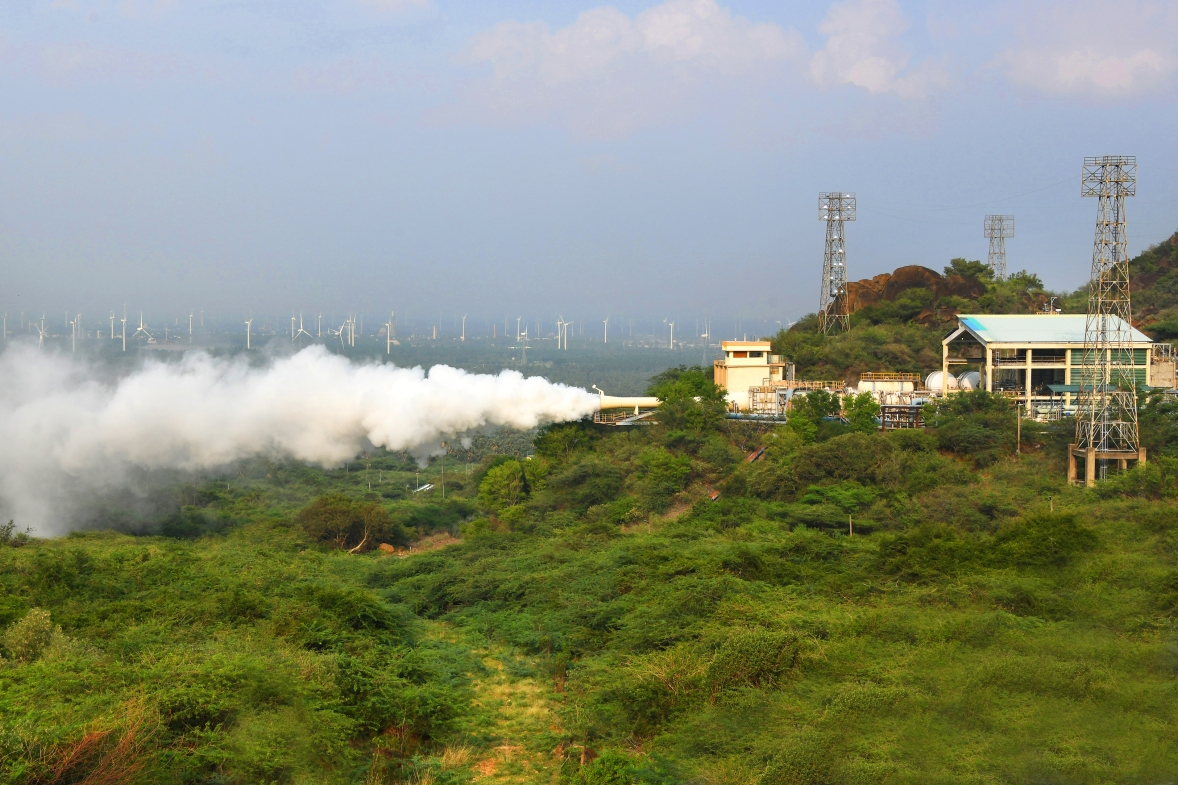
Friday's flight acceptance test comes within days of the launch of the first set of 36 OneWeb satellites by the NSIL from the Satish Dhawan Space Centre (SDSC- SHAR) in Sriharikota on October 23. According to OneWeb, its partnership with NSIL and ISRO demonstrated its commitment to provide connectivity across the length and breadth of India by 2023.
From Ladakh to Kanyakumari and Gujarat to Arunachal Pradesh, OneWeb will bring secured solutions not only to enterprises but also to towns, villages, municipalities and schools, including the hardest-to-reach areas across the country, it said.
"OneWeb's commitment to enhance connectivity in India is backed by Bharti Global, its largest investor", the company said.
NSIL Chairman & Managing Director D. Radhakrishnan had said: "We look forward to strengthening our partnership with OneWeb and utilising the potential that LEO connectivity has to deliver broadband services across India." Last Sunday's launch marked the rocket's entry into the global commercial launch service market, according to the Bengaluru-headquartered national space agency.
NSIL, a central public sector enterprise under the Department of Space, had earlier signed two launch service contracts with the Network Access Associated Limited (OneWeb) for launching a total of 72 OneWeb LEO (low earth orbit) satellites on-board ISRO's LVM3.
LVM3, ISRO's heaviest rocket, is capable of launching a four ton class of satellite to Geosynchronous Transfer orbit. LVM3 (Launch Vehicle Mark 3) is a three-stage vehicle with two solid motor strap-ons, a liquid propellant core stage and a cryogenic stage.

 www.ndtv.com
www.ndtv.com
ISRO Carries Out Key Test Of Its Heaviest Rocket's Engine. Details Here
Bengaluru: The flight acceptance hot test of CE-20 engine has been carried out in the High Altitude Test facility of ISRO Propulsion Complex (IPRC) at Mahendragiri in Tamil Nadu. The engine is assigned for the LVM3-M3 mission identified for launching the next 36 OneWeb India-1 satellites, the Indian Space Research Organisation said.
Sources told Press Trust of India these satellites of OneWeb, the London-based satellite communications company, are expected to be launched by the NewSpace India Limited (NSIL), the ISRO's commercial arm, aboard LVM3 early next year.

Friday's flight acceptance test comes within days of the launch of the first set of 36 OneWeb satellites by the NSIL from the Satish Dhawan Space Centre (SDSC- SHAR) in Sriharikota on October 23. According to OneWeb, its partnership with NSIL and ISRO demonstrated its commitment to provide connectivity across the length and breadth of India by 2023.
From Ladakh to Kanyakumari and Gujarat to Arunachal Pradesh, OneWeb will bring secured solutions not only to enterprises but also to towns, villages, municipalities and schools, including the hardest-to-reach areas across the country, it said.
"OneWeb's commitment to enhance connectivity in India is backed by Bharti Global, its largest investor", the company said.
NSIL Chairman & Managing Director D. Radhakrishnan had said: "We look forward to strengthening our partnership with OneWeb and utilising the potential that LEO connectivity has to deliver broadband services across India." Last Sunday's launch marked the rocket's entry into the global commercial launch service market, according to the Bengaluru-headquartered national space agency.
NSIL, a central public sector enterprise under the Department of Space, had earlier signed two launch service contracts with the Network Access Associated Limited (OneWeb) for launching a total of 72 OneWeb LEO (low earth orbit) satellites on-board ISRO's LVM3.
LVM3, ISRO's heaviest rocket, is capable of launching a four ton class of satellite to Geosynchronous Transfer orbit. LVM3 (Launch Vehicle Mark 3) is a three-stage vehicle with two solid motor strap-ons, a liquid propellant core stage and a cryogenic stage.

ISRO Carries Out Key Test Of Its Heaviest Rocket's Engine. Details Here
The flight acceptance hot test of CE-20 engine has been carried out in the High Altitude Test facility of ISRO Propulsion Complex (IPRC) at Mahendragiri in Tamil Nadu.

ISRO eyes next generation launch vehicle for heavier payloads
Another ISRO official said the new rocket would be helpful as India plans to have its own space station by 2035 and was also eyeing deep space missions, human space flights, cargo missions and putting multiple communication satellites into orbit at the same time. The NGLV is envisioned as a...
Synopsis
Another ISRO official said the new rocket would be helpful as India plans to have its own space station by 2035 and was also eyeing deep space missions, human space flights, cargo missions and putting multiple communication satellites into orbit at the same time. The NGLV is envisioned as a simple, robust machine designed for bulk manufacturing that will make space transportation more cost effective.
As India eyes setting up its own space station by 2035, the Indian Space Research Organisation (ISRO) has proposed to the industry to collaborate with it in developing a reusable rocket capable of carrying heavier payloads into orbit. Dubbed as the Next-Generation Launch Vehicle (NGLV), ISRO Chairman S Somanath said the space agency was working on the design of the rocket and would like the industry to collaborate with it in the development.
"The intent is to bring industry along in the development process. All the money need not be invested by us. We want the industry to invest to create this rocket for all of us," Somanath told PTI here. He said the rocket is planned to carry a 10 tonne payload in the Geostationary Transfer Orbit (GTO) or 20 tonnes to the low earth orbit.
Another ISRO official said the new rocket would be helpful as India plans to have its own space station by 2035 and was also eyeing deep space missions, human space flights, cargo missions and putting multiple communication satellites into orbit at the same time.
The NGLV is envisioned as a simple, robust machine designed for bulk manufacturing that will make space transportation more cost effective.
Somanath said the Polar Satellite Launch Vehicle (PSLV), ISRO's warhorse rocket, was based on the technology developed in the 1980's and cannot be used to launch rockets in the future.
ISRO plans to have the design of the NGLV ready within a year and offer it to the industry for production, with the first launch tentatively scheduled for 2030. The NGLV could be a three-stage rocket powered by green fuel combinations such as methane and liquid oxygen or kerosene and liquid oxygen.
According to a presentation made by Somanath at a conference earlier this month, the NGLV could offer launch costs of USD 1900 per kg of payload in the reusable form and USD 3,000 per kg in the expendable format.
India's space economy was pegged at USD 9.6 billion in 2020 and is expected to touch USD 12.8 billion by 2025, according to the ISpA-E&Y report titled 'Developing the Space Ecosystem in India: Focusing on Inclusive Growth'.
In dollar terms, the satellite services and applications segment would be the largest with a turnover of USD 4.6 billion by 2025, followed by ground segment at USD 4 billion, satellite manufacturing at USD 3.2 billion and launch services at USD 1 billion.
India's share in the launch services segment was pegged at USD 600 million in 2020 and is projected to grow at a compound annual growth rate of 13 per cent to reach USD 1 billion by 2025, the report said.
Bellatrix to set up $76-million ‘Space taxi’, propulsion systems R&D centre near Bengaluru
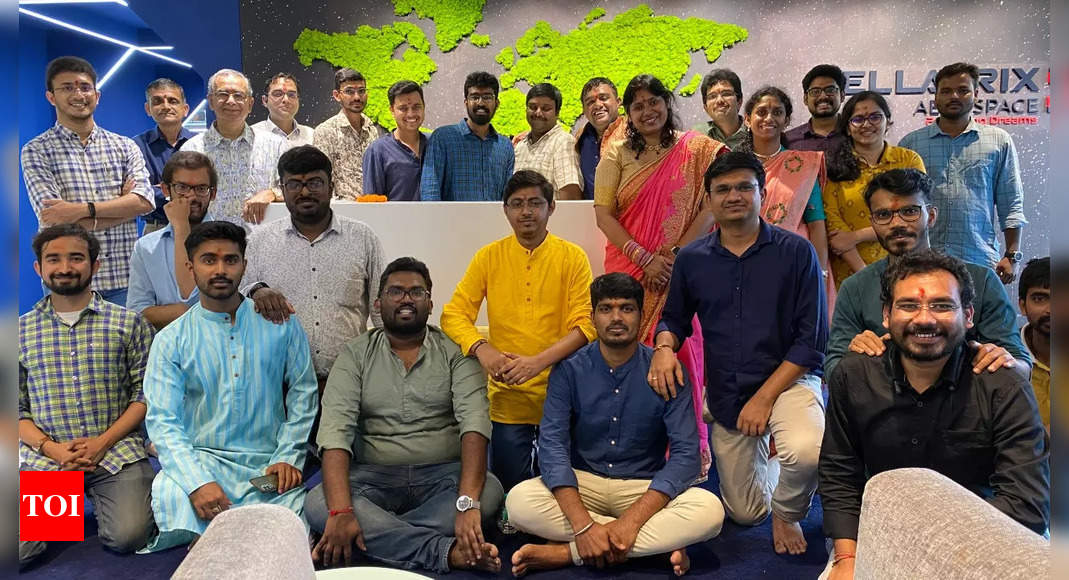
 timesofindia.indiatimes.com
timesofindia.indiatimes.com

Bellatrix to set up $76-million ‘Space taxi’, propulsion systems R&D centre & factory near Bengaluru | India News - Times of India
India News: BENGALURU: A research and development (R&D) centre and manufacturing factory for space taxis (orbital transfer vehicles or OTVs) and propulsion system.

India's first private sector rocket Vikram-S to launch in November: Here's what we know
The mission will be historic, since rockets in the country so far have been the domain of the Indian Space Research Organisation.
The company has already received a technical launch clearance from IN-SPACe for the launch. (Photo: Skyroot/Representative)
By Sibu Tripathi: In what will be India's maiden space launch from the private sector, Skyroot Aerospace is set to lift off the country's first privately developed rocket into space. The Prarambh mission is expected to launch in the second week of November on a demonstration flight with the Vikram-S launch vehicle.
The mission will be historic since rockets in the country so far have been the domain of the public sector with the Indian Space Research Organisation leading the development, design, and launch of space missions.
While the company has said that the mission could be launched between November 12-16, they are yet to release any details about the final launch date. The company has already received a technical launch clearance from IN-SPACe, the country's nodal agency for promoting and regulating space-tech players.
Speaking to indiatoday.in, Sireesh Pallikonda, Business Development Lead, Skyroot said that this will be a demonstration flight with three customer payloads. "We are yet to get a final date for the launch, but Vikram-S will launch between November12-16," he said.
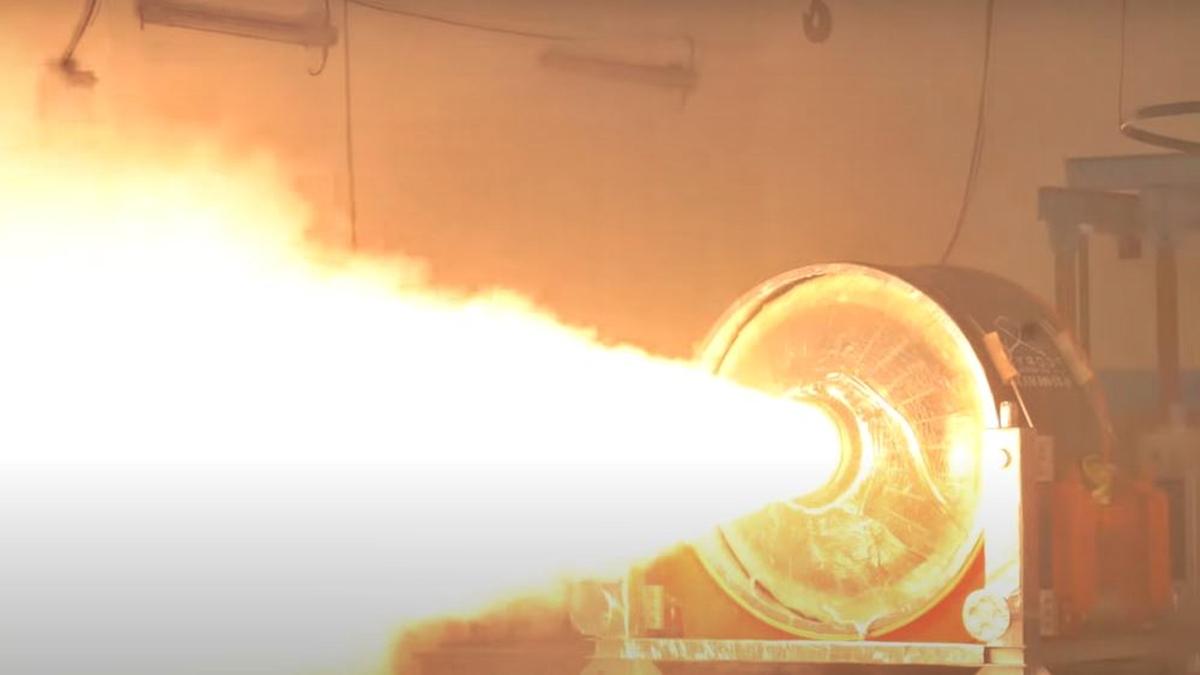
A static fire test of its Kalam-100 rocket that will power the Vikran-1 launch vehicle. (Photo: Skyroot)
"Thrilled to announce Prarambh, our maiden launch mission, also the first for the Indian private space sector, with launch window between 12-16 Nov '22," the Telangana-based aerospace company on Tuesday said, as Isro chairman S Somnath unveiled the mission patch for the maiden launch in Bengaluru.
Skyroot has been developing three variants of the Vikram rocket. While the Vikram-I can carry 480 kilograms of payload to Low Earth Orbit, the Vikram-II is equipped to lift off with 595 kilograms of cargo. Meanwhile, Vikram-III can launch with 815 kg to 500 km Low Inclination Orbit.
The Vikram-I launch vehicle will be powered by Kalam-100 rocket, which successfully went through a static fire test earlier this year.
The test was conducted at a facility of one of the company's investors, Solar Industries India.
"Super thrilled to announce our first launch mission #Prarambh from the beautiful island of Sriharikota. Crazy mixed feelings of excitement and nervousness," Pawan Chandana, Co-founder of Skyroot tweeted.
The Prarambh mission will be launched from the Satish Dhawan Space Center off the coast of Andhra Pradesh in Sriharikota.
The mission will be carrying three payloads, including a 2.5-kilogram payload that has been developed by students from several countries, including India, under the aegis of SpaceKidzIndia.
"We're thrilled and very happy to have our payloads flying aboard this historic mission, making a significant milestone in the commercial space sector of the country. It was an awesome experience working with you all," Space Kidz India said.
India's first private sector rocket Vikram-S to launch in November: Here's what we know
India's first private sector rocket Vikram-S to launch in November: Here's what we know
The mission will be historic, since rockets in the country so far have been the domain of the State-owned Indian Space Research Organisation.
The mission will be historic, since rockets in the country so far have been the domain of the State-owned Indian Space Research Organisation.
In Short
- Prarambh mission is expected to launch in the second week of November
- It will be a demonstration mission
- The mission will test the Vikram-S sub-orbital launch vehicle
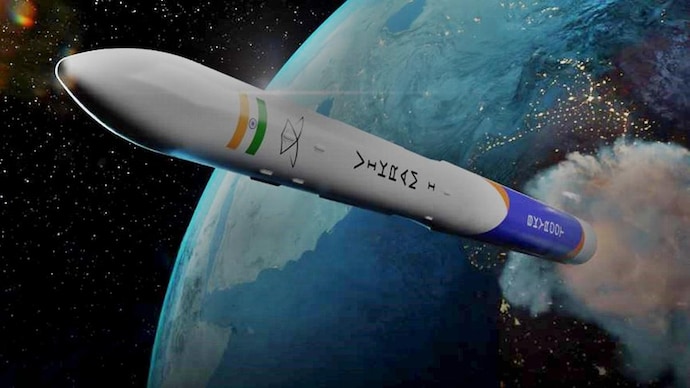
Vikram-I
By Sibu Tripathi: In what will be India's maiden space launch from the private sector, Skyroot Aerospace is set to lift off the country's first privately developed rocket into space. The Prarambh mission is expected to launch in the second week of November on a demonstration flight with the Vikram-S launch vehicle. The mission will be historic since rockets in the country so far have been the domain of the public sector with the Indian Space Research Organisation (ISRO) leading the development, design, and launch of space missions.
While the company has said that the mission could be launched between November 12-16, they are yet to release any details about the final launch date. The company has already received a technical launch clearance from IN-SPACe, the country's nodal agency for promoting and regulating space-tech players.
Speaking to indiatoday.in, Sireesh Pallikonda, Business Development Lead at Skyroot Aerospace, said that this will be a demonstration flight with three customer payloads. "We are yet to get a final date for the launch, but Vikram-S will launch between November12-16," he said.
"Thrilled to announce Prarambh, our maiden launch mission, also the first for the Indian private space sector, with launch window between 12-16 Nov '22," the Telangana state-based aerospace company on Tuesday said, as ISRO chairman S. Somnath unveiled the mission patch for the maiden launch in Bengaluru.
Mission patch for Prarambh
Skyroot has been developing three variants of the Vikram rocket. While the Vikram-I can carry 480 kilograms of payload to Low Earth Orbit, the Vikram-II is equipped to lift off with 595 kilograms of cargo. Meanwhile, Vikram-III can launch with 815 kg to 500 km Low Inclination Orbit.
The Vikram-I launch vehicle will be powered by Kalam-100 rocket engine, which successfully went through a static fire test earlier this year. The test was conducted at a facility of one of the company's investors, Solar Industries India.
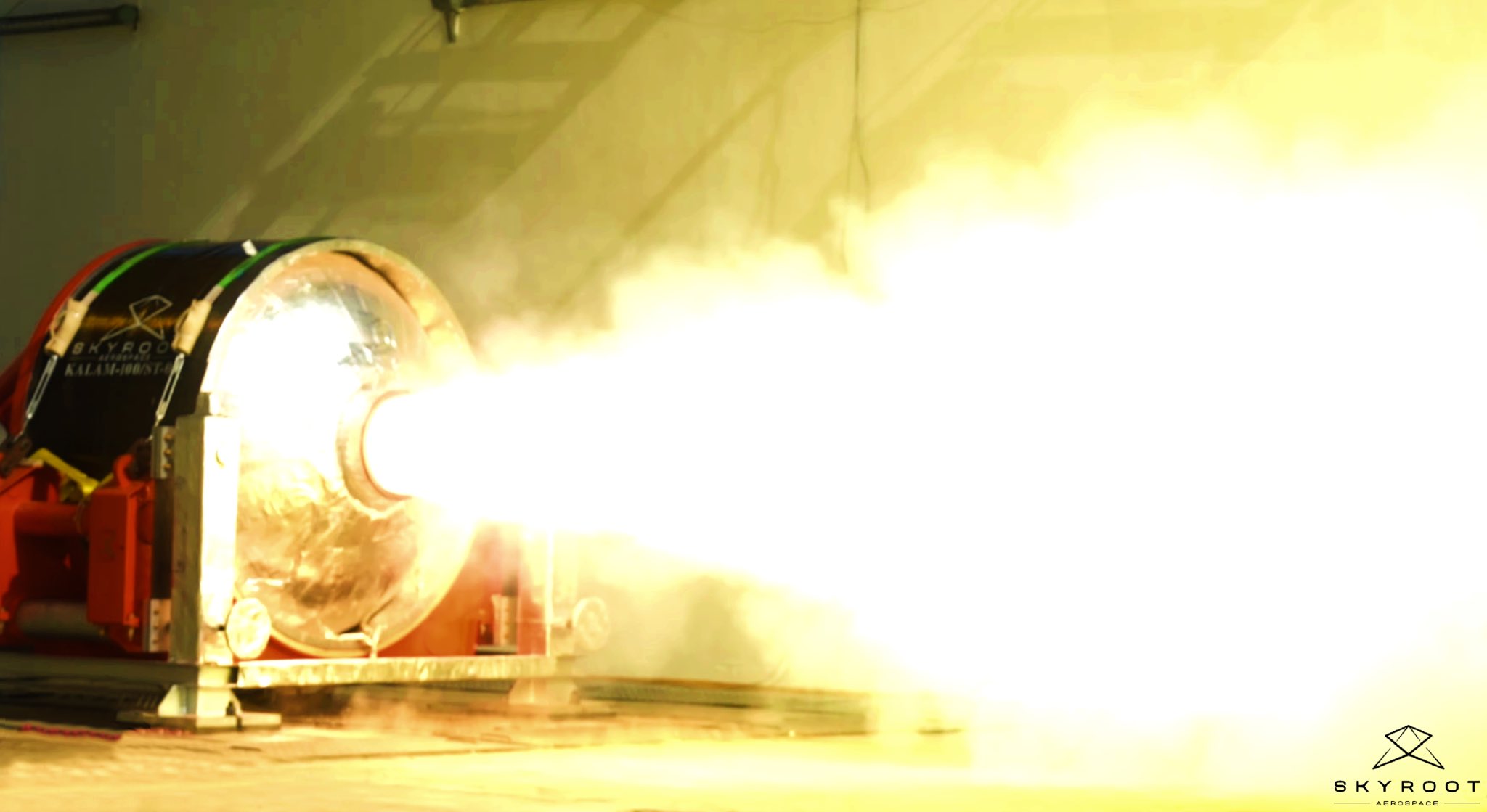
Kalam-100 static fire test
"Super thrilled to announce our first launch mission #Prarambh from the beautiful island of Sriharikota. Crazy mixed feelings of excitement and nervousness," Pawan Chandana, Co-founder of Skyroot tweeted. The Prarambh mission will be launched from the Satish Dhawan Space Center (SDSC) on the island of Sriharikota, off the coast of Andhra Pradesh state.
The mission will be carrying three payloads, including a 2.5-kilogram payload that has been developed by students from several countries, including India, under the aegis of SpaceKidzIndia. "We're thrilled and very happy to have our payloads flying aboard this historic mission, making a significant milestone in the commercial space sector of the country. It was an awesome experience working with you all," Space Kidz India said.

India's first private sector rocket Vikram-S to launch in November: Here's what we know
The mission will be historic, since rockets in the country so far have been the domain of the Indian Space Research Organisation.
Agnikul Cosmos tests India's first Privately-developed Semi-Cryogenic Engine
Agnikul Cosmos tests India's first Privately-developed Semi-Cryogenic Engine
The hot test was conducted by firing the Agnilet Engine for 15 seconds on November 4 at ISRO's Vertical Test Facility.
The hot test was conducted by firing the Agnilet Engine for 15 seconds on November 4 at ISRO's Vertical Test Facility.
In Short
- The test was part of the memorandum signed between ISRO and Agnikul Cosmos
- The hot test was conducted at ISRO's Vikram Sarabhai Space Centre
- The engine uses Liquid oxygen and Aviation Turbine Fuel as propellent

Agnilet Semi-cryo engine undergoing hot test at VTF, ISRO
By India Today Web Desk: The India Space Research Organisation (ISRO) on Tuesday said that it has successfully conducted a hot test of a rocket engine developed by Agnikul Cosmos, an aerospace startup. The hot test was conducted at ISRO's lead center for the development of launch vehicles, Vikram Sarabhai Space Centre (VSSC). The hot test was conducted by firing the Agnilet Engine for 15 seconds on November 4 at its Vertical Test Facility, Thumba Equatorial Rocket Launching Station (TERLS), Thiruvananthapuram. The engine is a regeneratively cooled 1.4 kN semi-cryogenic engine that works at a chamber pressure of 10.8 bar and uses Liquid oxygen and Aviation Turbine Fuel (ATF) as propellants.
The test was part of the memorandum signed between ISRO and M/s Agnikul Cosmos Pvt. Ltd. to provide an opportunity for Indian space start-ups to use the facilities of ISRO through IN-SPACe.
"This engine is realised through state-of-the-art 3D printing technology and the material of construction is INCONEL-718," ISRO said in a statement.
The technologies developed will find application on the upper stages of the Agnibaan small satellite launch vehicle under development by Agnikul Cosmos
The announcement came hours after another aerospace startup Skyroot said that it will conduct the maiden launch of a privately developed rocket in the second week of November. The Prarambh mission will launch from ISRO's Satish Dhawan Space Centre in Sriharikota.
While the company has said that the mission could be launched between November 12-16, they are yet to release any details about the final launch date. The company has already received a technical launch clearance from IN-SPACe, the country's nodal agency for promoting and regulating space-tech players.
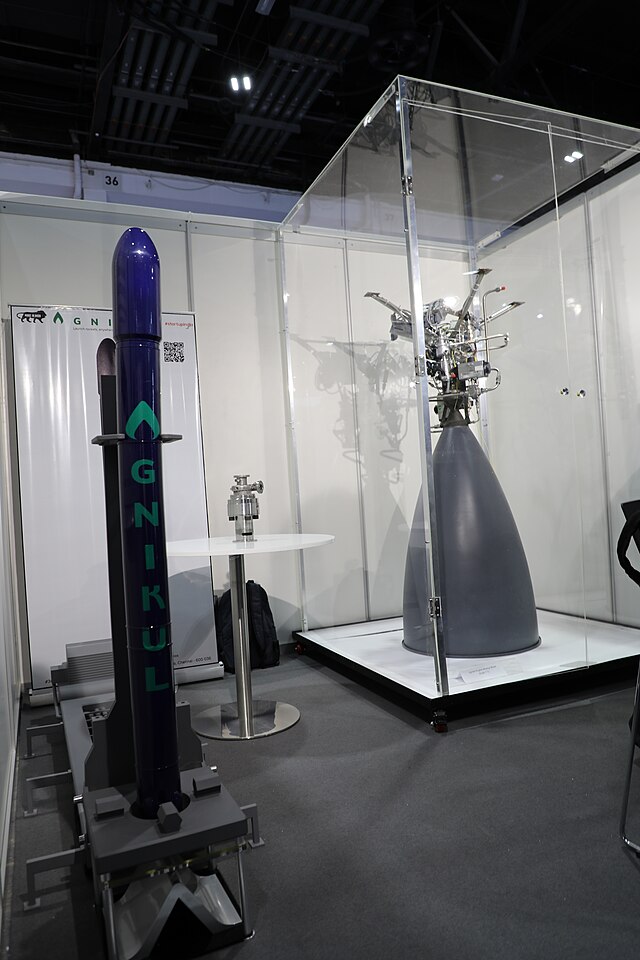
On display at the International Astronautical Congress 2021 in Dubai
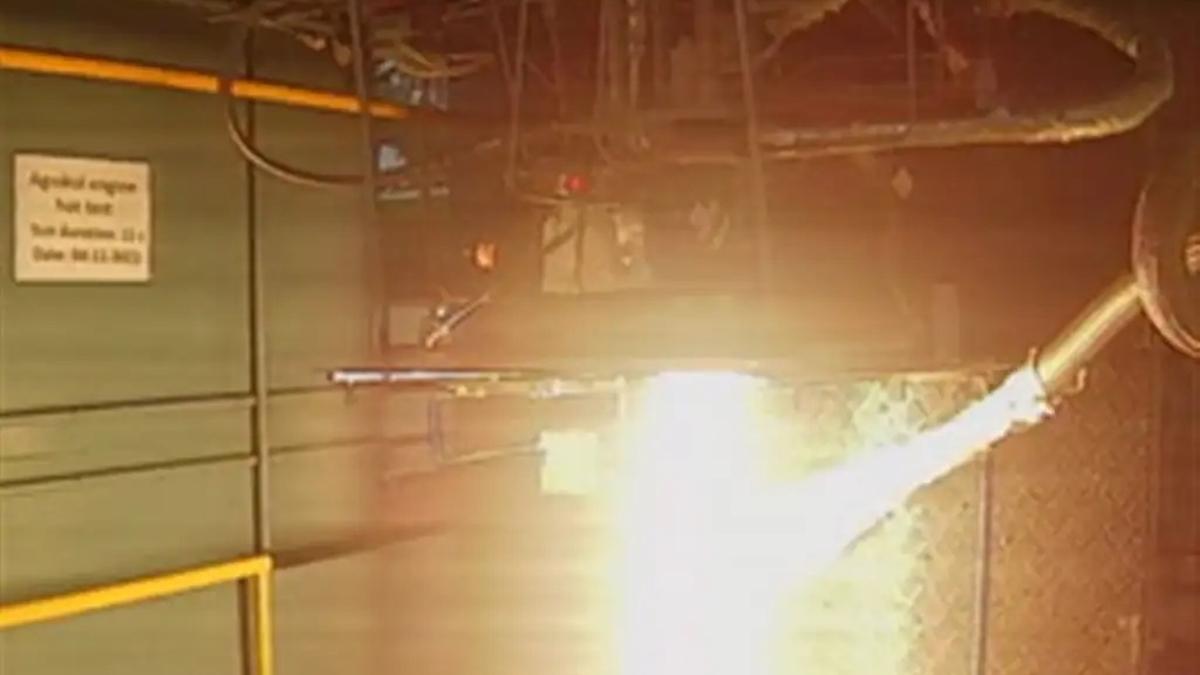
Isro tests rocket engine developed by startup Agnikul Cosmos
The hot test was conducted by firing the Agnilet Engine for 15 seconds on November 4 at Isro's Vertical Test Facility.
Successful CE20 uprated Engine Hot Test with 21.8 T vacuum thrust
A few weeks ago, the Indian Space Research Organisation (ISRO) raised its performance bar yet again when its commercial arm successfully placed 36 communication satellites of London-based OneWeb in Low Earth Orbit (LEO)—the new genre of satellites. The satellites—part of a constellation of owned by OneWeb—proposes to reinvent communication by enabling the processing of high-volume messaging and data with minimal delay using satellites. They were launched using the LVM3 (Launch Vehicle Mark III), developed indigenously by ISRO to place geostationary satellites with a payload capacity of 4T; but can also be employed for launching 6T payloads for LEO. The launch was a win-win for all stakeholders. This was particularly true for ISRO. Its commercial arm, NewSpace India Limited (NSIL), successfully scripted another commercial deal, and the first employed the LMV3. The first successful execution of a commercial deal by NSIL was the launch of a Brazilian satellite, PSLV-C51/Amazonia-1, in March last year. Significantly, the latest launch reveals how the private sector is graduating from being a mere vendor to a commercial partner to ISRO. This is a big plus, besides being another mindset reset and creating a new ecosystem to encourage innovation and startups in space. It is the beginning of the pivot to private-funded and private-conducted space activities in India. In short, India has come up with a new playbook to realize its commercial ambitions in space. To understand this and more we spoke to Narayan Prasad, COO, Satsearch—the Netherlands-based firm trying to build the global marketplace for the space industry.
fire starter
Well-known member
Materials for Indian Space Program: An Overview
NEW DELHI: Late last month, the Indian Space Research Organisation (ISRO) successfully launched its heaviest rocket, Launch Vehicle Mark-3 (LVM-3), putting in orbit 36 satellites of a UK-based satellite communications company. This was also the first commercial operation of LVM-3. India’s space economy is very, very low (about 2 per cent of the global space economy), says ISRO chairman S. Somnath. Speaking to StratNews Global Editor-in-Chief Nitin A. Gokhale, he said there’s a need to create an ecosystem where manufacturing (satellites, launch vehicles) improves and this can happen only when the private sector, especially big industries and start-ups, get involved. Tune in for more.
I don't believe there's money to made in space for launch providers. SpaceX has absolutely turned the table on that. You(or anyone) cannot compete with partially-reusable Falcon 9 on cost. One of the boosters has been reused 14 times already. And they're reusing fairings too. The only cost of the launch is the second-stage and some operational cost. On top of that, they have ride sharing service. They launch small satellites to SSO for as little as $275k.NEW DELHI: Late last month, the Indian Space Research Organisation (ISRO) successfully launched its heaviest rocket, Launch Vehicle Mark-3 (LVM-3), putting in orbit 36 satellites of a UK-based satellite communications company. This was also the first commercial operation of LVM-3. India’s space economy is very, very low (about 2 per cent of the global space economy), says ISRO chairman S. Somnath. Speaking to StratNews Global Editor-in-Chief Nitin A. Gokhale, he said there’s a need to create an ecosystem where manufacturing (satellites, launch vehicles) improves and this can happen only when the private sector, especially big industries and start-ups, get involved. Tune in for more.
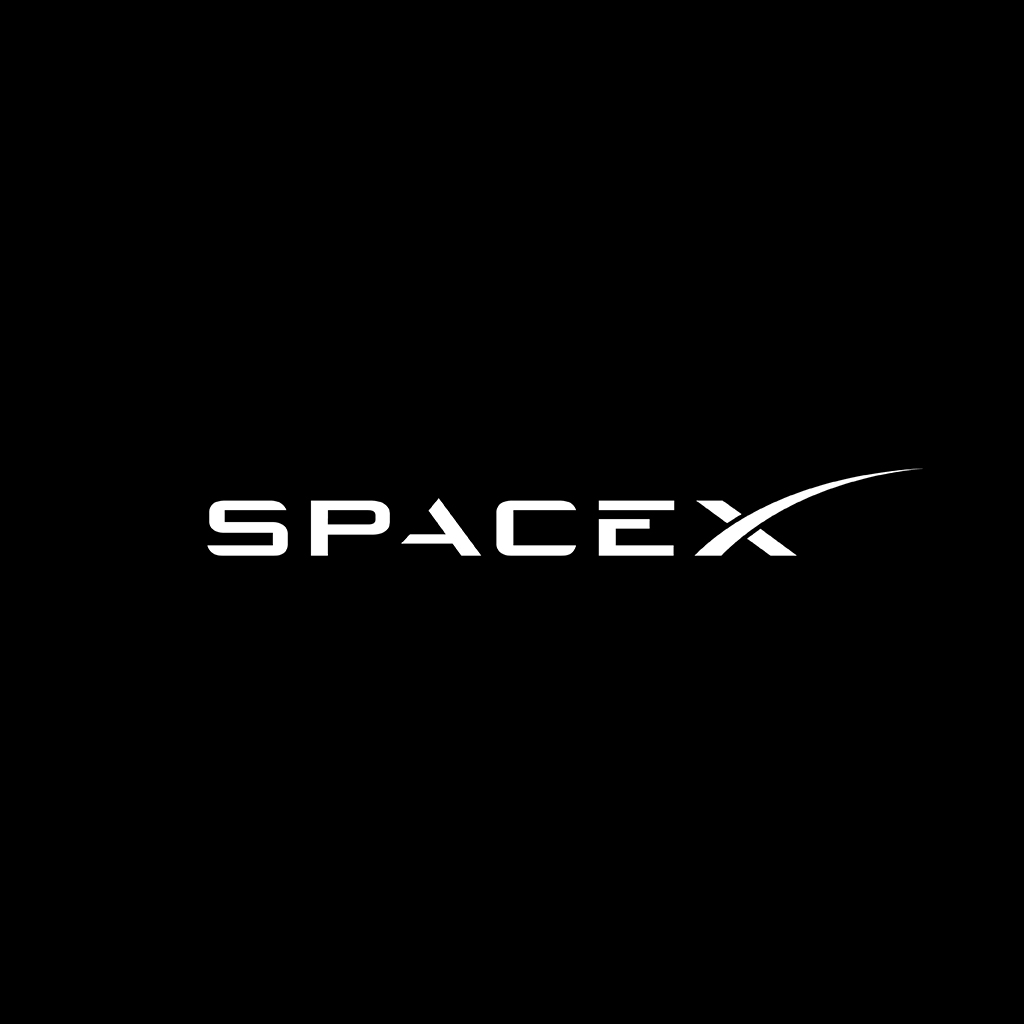
On top of that, if they manage to put Starship in service and if it was really fully and rapidly reusable then it's game over for everyone in the industry. Even small launch vehicles for small satellites couldn't compete with that rocket whose only expense is the propellant. From that point on the only objective of other countries' efforts for launching rockets could be to preservation of independent space-access capability. Or they could venture the path of developing fully-reusable rockets but that's a very long and painful road to walk. I'm not sure how many countries have the resources and experience to tackle that problem considering they haven't recovered even one booster whereas SpaceX has recovered over 150 boosters so far. They have a good two decades lead in the industry.
I don't believe there's money to made in space for launch providers. SpaceX has absolutely turned the table on that. You(or anyone) cannot compete with partially-reusable Falcon 9 on cost. One of the boosters has been reused 14 times already. And they're reusing fairings too. The only cost of the launch is the second-stage and some operational cost. On top of that, they have ride sharing service. They launch small satellites to SSO for as little as $275k.

On top of that, if they manage to put Starship in service and if it was really fully and rapidly reusable then it's game over for everyone in the industry. Even small launch vehicles for small satellites couldn't compete with that rocket whose only expense is the propellant. From that point on the only objective of other countries' efforts for launching rockets could be to preservation of independent space-access capability. Or they could venture the path of developing fully-reusable rockets but that's a very long and painful road to walk. I'm not sure how many countries have the resources and experience to tackle that problem considering they haven't recovered even one booster whereas SpaceX has recovered over 150 boosters so far. They have a good two decades lead in the industry.
We are talking about the space economy as a whole here, estimated at around 400 - 500 billion USD currently in the world and projected to reach around 1 trillion USD by 2040 (and maybe sooner).
Space launch revenue represents maybe around 15 billion USD revenue in comparison ~3% of the space economy.
So while it is important for India to keep and have a significant foot in the door there (especially given the strategic benefit) till more breakouts can be achieved down road with more technological innovation and maturity of scale then, it specifically is not the larger picture by far for the ecosystem development being talked about in the interview.
The larger Indian space economy will be expanded and guided price-signalling, investment and capacity wise largely by India's 3.5 trillion market capitalisation, ~ 65 unicorns and other very positive forces, using what ISRO has kept relatively closer to chest till now given slower pace of earlier era of Indian private sector.
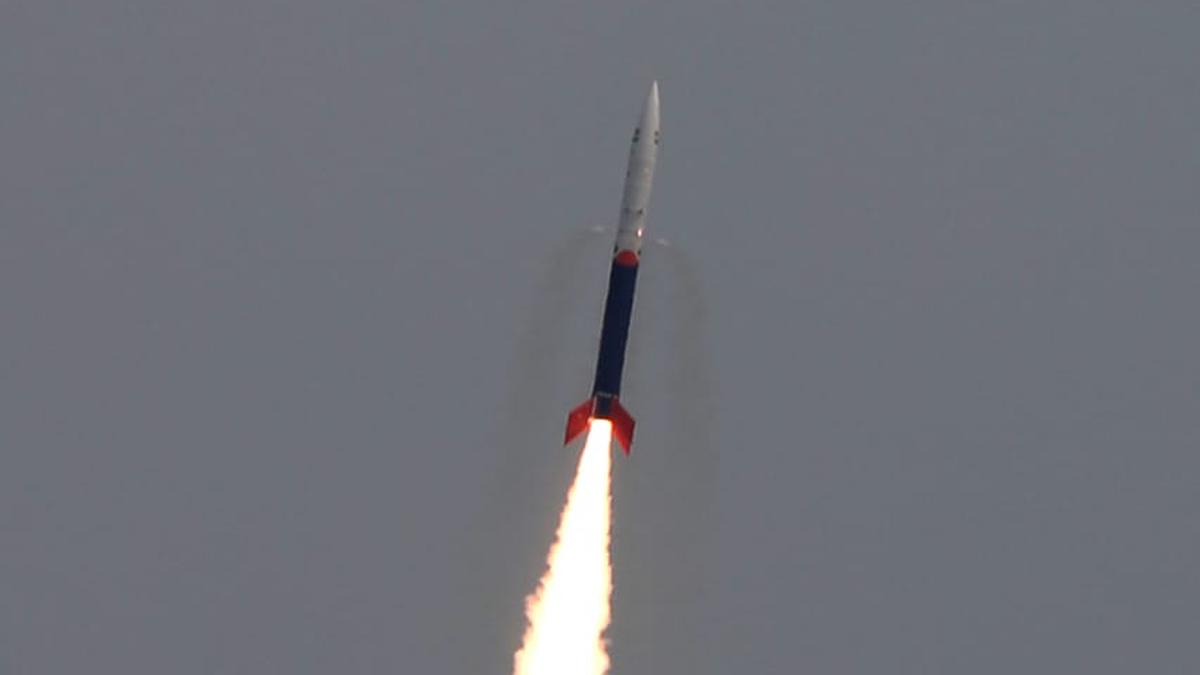
Vikram-S, India’s first private rocket, lifts off from ISRO spaceport
The 6-metre tall launch vehicle Vikram-S is named after Vikram Sarabhai, the father of the country’s space programme, and lifted off at 11.30 a.m.
Vikram-S, India’s first private rocket, lifts off from ISRO spaceport
The 6-metre tall launch vehicle Vikram-S is named after Vikram Sarabhai, the father of the country’s space programme, and lifted off at 11.30 a.m.
November 18, 2022 11:57 am | Updated 08:26 pm IST - SriharikotaSANGEETHA KANDAVEL
It was a historic moment when Vikram-S, India’s first privately-developed rocket, lifted off precisely at 11.30 AM on November 18, 2022 from Indian Space Research Organisation’s (ISRO) launchpad in Sriharikota.
Developed by Hyderabad-based startup Skyroot Aerospace Private Limited, the 6-metre tall vehicle hit a peak altitude of 89.5 kilometers and then splashed into the Bay of Bengal about five minutes after the launch. This mission was titled Prarambh.
The rocket Vikram-S is a single-stage solid fuelled, sub-orbital rocket developed over two years by incorporating advanced technologies including carbon composite structures and 3D-printed components.
Equipped with a gross lift off mass of 545kg, and payload mass of 80 kg, Vikram-S carried with it three customer payloads, which will map the measurement and validation of certain flight parameters and payload integration processes.
This was a technology demonstration flight to showcase the capabilities of the company. The rocket will help validate the technologies that will be used in the subsequent Vikram-1 orbital vehicle of Skyroot that is planned for launch next year, subject to technical clearance by IN-SPACe.
Founded by Pawan Kumar Chandana and Naga Bharath Daka in June 2018 Skyroot Aerospace is a two-time national award-winning space startup, with 200 employees, and is the largest funded private space start up in India with ₹526 crore raised as capital till date.
“We started four years ago and when we started there was no policy but we took that leap with faith. But now the policy has come up and we got support from ISRO,” Mr Chandana said.
“Vikram-S rocket meets all flight parameters - 89.5 kms peak altitude achieved and completed required mission,” he added.

Vikram-S blasted off the launcher at the Satish Dhawan Space Centre, Sriharikota. It had a splashdown on the Bay of Bengal with the total mission lasting 300 seconds. | Photo Credit: Ragu R.
At a press meet after the launch Jitendra Singh, Union Minister of State (Independent Charge) Science & Technology; Minister of State (Independent Charge) Earth Sciences; MoS PMO, Personnel, Public Grievances, Pensions, Atomic Energy and Space, called this a “New beginning, a new dawn. This is the beginning of building India’s own space ecosystem.”
He pointed out that Prime Minister Narendra Modi, opened up the space sector for private stakeholders in June 2020 and this has enabled unlocking of the immense potential of the Indian Space Sector.
S. Somnath, Chairman, Indian Space Research Organisation (ISRO) and Secretary Department of Space (DoS) said, “We thought it’s a difficult journey but they (Skyroot team) proved us wrong.”
Pawan K Goenka, Chairman of IN-SPACe, Department of Space said that 55 years ago was when our first Rohini was launched and today we are starting another journey but the difference is this is by a private player.
He further said that this maiden rocket launch for Skyroot Aerospace is perhaps the most important milestone for the Indian private space sector since the space reforms announced by Government of India and hints at the rapid transformative journey we’re witnessing in India’s space sector. “Though one small step, it is a giant leap to demonstrate the capabilities of the Indian Space sector,” he added.
The Indian National Space Promotion and Authorisation Centre (IN-SPACe) has been operating as a single-window, autonomous nodal agency of Department of Space (DOS) to boost the private space sector economy in India.
It has given five authorizations to the Space NGEs for undertaking space activities in India, in six months and signed Sixteen MoUs. Till date, IN-SPACe has received more than 150 applications from Space NGEs for Authorization, Facilitation, and Promotion.
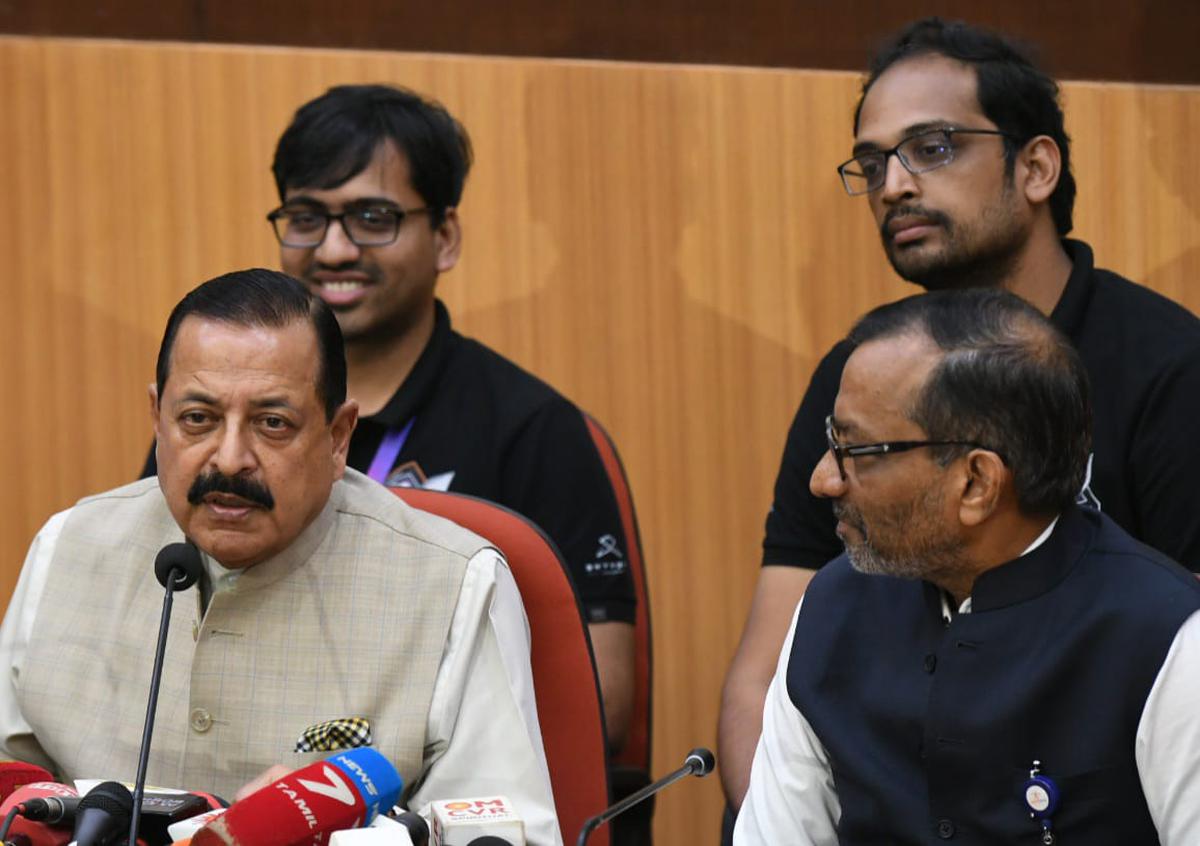
Union Minister Jitendra Singh and others addressing the media at Sriharikota on Friday. | Photo Credit: R. Ragu
Friday’s mission is considered to be a significant milestone for Skyroot Aerospace as it would help test and validate majority of the technologies in the Vikram series of orbital class space launch vehicles, including many sub-systems and technologies that would be tested before lift-off and post lift off phases of the launch.
‘Fun-Sat’, a 2.5 kgs payload belonging to Chennai-based aerospace startup Spacekidz, has been developed by students from India, the United States, Singapore and Indonesia.
The 545 kg Vikram launch vehicle consists of the Vikram II and Vikram III series.
It took Skyroot Aerospace about two years to develop and has been built using advanced technologies including carbon composite structures and 3D-printed components. The firm founded by Pawan Kumar Chandana and Naga Bharath Daka in June 2018 is a two-time national award-winning space startup, with 200 employees, and is the largest funded private space start up in India with ₹526 crore raised as capital till date.
==================================================



